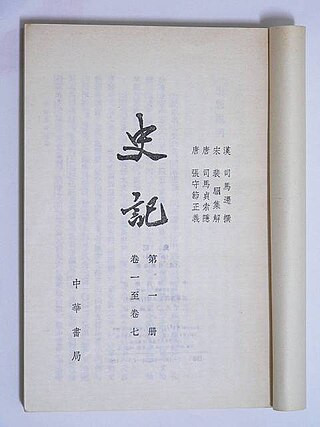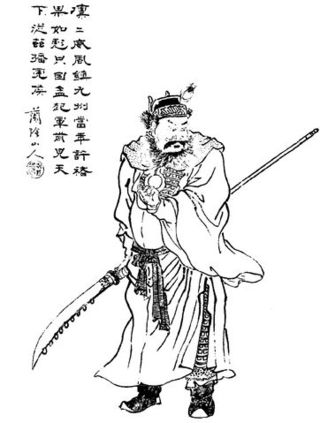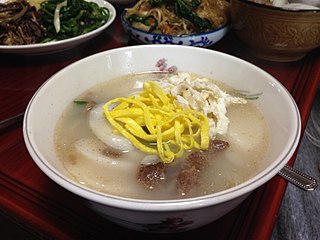Related Research Articles

The traditional Chinese calendar is a lunisolar calendar which identifies years, months, and days according to astronomical phenomena. In China, it is defined by the Chinese national standard GB/T 33661-2017, "Calculation and Promulgation of the Chinese Calendar", issued by the Standardization Administration of China on May 12, 2017.
Chinese classic texts or canonical texts or simply dianji (典籍) refers to the Chinese texts which originated before the imperial unification by the Qin dynasty in 221 BC, particularly the "Four Books and Five Classics" of the Neo-Confucian tradition, themselves a customary abridgment of the "Thirteen Classics". All of these pre-Qin texts were written in classical Chinese. All three canons are collectively known as the classics.

Records of the Grand Historian, also known by its Chinese name Shiji, is a monumental history of China that is the first of China's 24 dynastic histories. The Records was written in the late 2nd century BC to early 1st century BC by the ancient Chinese historian Sima Qian, whose father Sima Tan had begun it several decades earlier. The work covers a 2,500-year period from the age of the legendary Yellow Emperor to the reign of Emperor Wu of Han in the author's own time, and describes the world as it was known to the Chinese of the Western Han dynasty.

In various East Asian languages such as Chinese, Japanese, and Korean as well as Vietnamese, the phrase "Wànsuì", "Banzai", "Manse", and "Vạn tuế", literally meaning "ten thousand years" is used to wish long life, and is typically translated as "Long live" in English. The phrase originated in ancient China as an expression used to wish long life to the emperor. Due to the historical political and cultural influence of Chinese culture on the East Asian cultural sphere, in the area, and in particular of the Classical Chinese language, cognates with similar meanings and usage patterns have appeared in many East Asian languages and Vietnamese. In some countries, this phrase is mundanely used when expressing feeling of triumph, typically shouted by crowds.

Lunar New Year is the first new moon of a lunar calendar or lunisolar calendar year, whose months are moon cycles. The event is celebrated by numerous cultures in various ways at diverse dates.

Zongzi, rouzong or simply zong is a traditional Chinese rice dish made of glutinous rice stuffed with different fillings and wrapped in bamboo leaves, or sometimes with reed or other large flat leaves. They are cooked by steaming or boiling. In the Western world, they are also known as rice dumplings or sticky rice dumplings.

Xu Chu, courtesy name Zhongkang, was a Chinese military general who lived during the late Eastern Han dynasty and the Three Kingdoms period of China. He started his career as a bodyguard to the warlord Cao Cao and later became a general in the state of Wei during the Three Kingdoms period. He was described to be a big and strong man, yet simple minded and honest, so he was nicknamed "Tiger Fool" by his men. After his death, he was posthumously honoured with the title "Marquis Zhuang", which literally means "robust marquis".

The Book of Rites, also known as the Liji, is a collection of texts describing the social forms, administration, and ceremonial rites of the Zhou dynasty as they were understood in the Warring States and the early Han periods. The Book of Rites, along with the Rites of Zhou (Zhōulǐ) and the Book of Etiquette and Rites (Yílǐ), which are together known as the "Three Li (Sānlǐ)," constitute the ritual (lǐ) section of the Five Classics which lay at the core of the traditional Confucian canon. As a core text of the Confucian canon, it is also known as the Classic of Rites or Lijing, which some scholars believe was the original title before it was changed by Dai Sheng.

Duke Wen of Jin, born Chong'er, was a scion of the royal house of Jin during the Spring and Autumn Period of Chinese history. He famously endured a long period of exile from his realm before finally being restored to power and rapidly leading Jin to hegemony over the other Chinese states of his time. He is a figure in numerous Chinese legends, including those about his loyal courtier Jie Zhitui, whose death is said to have inspired China's Cold Food and Qingming Festivals.

Tteokguk (떡국) or sliced rice cake soup is a traditional Korean dish eaten during the celebration of the Korean New Year. The dish consists of the broth/soup (guk) with thinly sliced rice cakes (tteok). It is tradition to eat tteokguk on New Year's Day because it is believed to grant the people good luck for the year and gain a year of age. It is usually garnished with thin julienned cooked eggs, marinated meat, gim (김), and sesame oil (참기름).
Mr. He's jade or Heshibi was a sacred ceremonial bi used as regalia, which had an important role in Chinese history. First appearing during the mid-8th century BCE, it was cut into a ritual bi and recognized as an imperial treasure. The Heshibi became the object of contention among the Warring States, stolen from Chu circa 4th century BCE, acquired by the Zhao, and temporarily traded to Qin in 283 BCE. When the Qin dynasty was founded in 221 BCE, the Heshibi was carved into the Heirloom Seal of the Realm, symbol of the Mandate of Heaven, and subsequently transferred through successive Chinese dynasties until it was lost during the 10th century.

The Cold Food or Hanshi Festival is a traditional Chinese holiday which developed from the local commemoration of the death of the Jin nobleman Jie Zitui in the 7th century BC under the Zhou dynasty, into an occasion across East Asia for the commemoration and veneration of ancestors by the 7th-century Tang dynasty. Its name derives from the tradition of avoiding the lighting of any kind of fire, even for the preparation of food. This practice originally occurred at midwinter for as long as a month, but the hardship this involved led to repeated attempts to ban its observance out of concern for its practitioners. By the end of the Three Kingdoms Period, it was limited to three days in the spring around the Qingming solar term. Under the Tang, ancestral observance was limited to the single day which is now the Tomb-Sweeping Festival. The Tomb-Sweeping Festival is a official holiday in several countries, and the Cold Food Festival which stretches either side of it continues to see some observance in China, South Korea, and Vietnam.
The term Nine Provinces or Nine Regions, is used in ancient Chinese histories to refer to territorial divisions or islands during the Xia and Shang dynasties and has now come to symbolically represent China. "Province" is the word used to translate zhou (州) – since before the Tang dynasty, it was the largest Chinese territorial division. Although the current definition of the Nine Provinces can be dated to the Spring and Autumn and Warring States periods, it was not until the Eastern Han dynasty that the Nine Provinces were treated as actual administrative regions.

Wu Yun, better known by his courtesy name Zixu, was a Chinese military general and politician of the Wu kingdom in the Spring and Autumn period. Since his death, he has evolved into a model of loyalty in Chinese culture. He is the best known historical figure with the Chinese family name "Wu" (伍). All branches of the Wu clan claim that he was their "first ancestor".

Seollal is a traditional festival and national holiday commemorating the first day of the lunisolar calendar. It is one of the most important traditional holidays for ethnic Koreans, being celebrated in both North Korea and South Korea as well as Korean diaspora all around the world. It originates in native folk festivals as well as seasonal customs of Koreanic speakers and contrary to common belief, refers to the period of time between the calendrical new years holiday itself and the rise of the first full moon.

Patjuk is a type of Korean juk consisting of red beans and rice. It is commonly eaten during the winter season in Korea, and is associated to dongji, as people used to believe that the red color of patjuk drives off baneful spirits.

Chinese New Year is the festival that celebrates the beginning of a new year on the traditional lunisolar Chinese calendar. In Chinese, the festival is commonly referred to as the Spring Festival as the spring season in the lunisolar calendar traditionally starts with lichun, the first of the twenty-four solar terms which the festival celebrates around the time of the Chinese New Year. Marking the end of winter and the beginning of the spring season, observances traditionally take place from New Year's Eve, the evening preceding the first day of the year to the Lantern Festival, held on the 15th day of the year. The first day of Chinese New Year begins on the new moon that appears between 21 January and 20 February.

Jie Zhitui, also known as Jie Zitui, was an ancient aristocrat who served the Jin prince Chong'er during the Spring and Autumn Period of Chinese history. Chinese legend holds that when Chong'er finally ascended to power as the duke of Jin, Jie either refused or was passed over for any reward, despite his great loyalty during the prince's times of hardship. Jie then retired to the forests of Jin in what is now central Shanxi with his mother. Supposedly, the duke so desired to repay Jie's years of loyalty that, when Jie declined to present himself at court, he ordered a forest fire to compel the recluse out of hiding. Instead, Jie and his mother were killed by the fire on Mt Mian. By the Han, Jie was being revered in central Shanxi as a Taoist immortal. He was annually commemorated with a ritual avoidance of fire that, despite many official bans, eventually became China's Cold Food and Qingming Festivals.
Shentu or Shenshu and Yulü or Yulei are a pair of deities in Chinese mythology who punished evil spirits by binding them in reed ropes and feeding them to tigers. Their images together with reed rope seasonally adorned the doors or gates to ward off evil, and are considered the earliest examples of Menshen venerated under such practice. Later traditions identified other gods or deified people as gate deities.
Yang Xi, courtesy name Wenran, was an official of the state of Shu Han during the Three Kingdoms period of China. He is best known for writing the Ji Han Fuchen Zan, a collection of praises of notable persons who served in the Shu Han state. Chen Shou, the third-century historian who wrote the Records of the Three Kingdoms (Sanguozhi), extensively quoted and annotated Yang Xi's collection.
References
Citations
- 1 2 Wang (1990) , p. 98.
- 1 2 3 Hureau (2010), p. 1238–9.
- 1 2 3 4 5 Chapman (2014), p. 468.
- 1 2 Deng (1998), p. 67.
- ↑ Saitō (2015), p. 45.
- 1 2 3 4 Theobald (2010).
- 1 2 EKSC (2014) , p. 45.
- ↑ Tian (2005), p. 262.
- ↑ Holzman (1986), p. 60.
- 1 2 Chittick (2009) , p. 168.
- 1 2 Park (2015) , p. 266.
- ↑ Chapman (2014) , p. 482.
- 1 2 3 4 5 Holzman (1986), p. 61.
- 1 2 3 Chapman (2014) , p. 483.
- 1 2 3 4 5 6 7 Chapman (2014) , p. 469.
- ↑ Xiong (2017), "Boling" & "Dingzhou".
- ↑ Book of Sui, vol. 58, §§1421–2. (in Chinese)
- ↑ Chapman (2014) , p. 487.
- ↑ Rites of Zhou, §36. (in Chinese)
- ↑ Holzman (1986), p. 56.
- ↑ Moriya (1963), pp. 320–92.
- ↑ Turban (1971).
- ↑ Moriya & al. (1978).
- ↑ Chapman (2014) , p. 470.
- ↑ EKFB (2014), p. 262.
Bibliography
- "Seol: Food: Seju", Encyclopedia of Korean Seasonal Customs, Encyclopedia of Korean Folklore and Traditional Culture, Vol. I, Seoul: National Folk Museum of Korea, 2014-10-30, pp. 44–5, ISBN 978-8992128926 .
- "Patjuk", Encyclopedia of Korean Folk Beliefs, Encyclopedia of Korean Folklore and Traditional Culture, Vol. II, Seoul: National Folk Museum of Korea, 2014, pp. 262–3, ISBN 9788928900572 .
- Chapman, Ian (2014), "Festival and Ritual Calendar: Selections from Record of the Year and Seasons of Jing-Chu", Early Medieval China: A Sourcebook, New York: Columbia University Press, pp. 468–493, ISBN 978-0-231-15987-6 .
- Chittick, Andrew (2009), Patronage and Community in Medieval China: The Xiangyang Garrison, 400–600 CE, Albany: State University of New York Press, ISBN 978-1-4384-2897-0 .
- Deng Guanghua (1998), "Nuo—Culture and Music: Traces of Chinese Primitive Music in Nuoyi and Nuoxi", Musical Performance, Vol. 2, No. 1: Tradition and Change in the Performance of Chinese Music, Singapore: Overseas Publishers Association, pp. 57–68, ISBN 9789057550409 .
- Holzman, Donald (June 1986), "The Cold Food Festival in Early Medieval China", Harvard Journal of Asiatic Studies, vol. 46, Cambridge: Harvard University Press, pp. 51–79, JSTOR 2719075 .
- Hureau, Sylvie (2010), "Buddhist Rituals", Early Chinese Religion, Pt. II: The Period of Division (220–589 AD), Vol. II, Handbook of Oriental Studies, Sect. 4: China, Leiden: Koninklijke Brill, pp. 1207–1244, ISBN 978-90-04-16835-0 .
- Moriya, Mitsu (1963), 《中国古歲時記の研究》 [Chūgoku Ko Saijiki no Kenkyū, A Study of China's Old Seasonal Records], Tokyo: Teikoku Shoin. (in Japanese) & (in Chinese)
- Moriya, Mitsu; et al. (eds.), 荊楚歲時記 [Keiso Saijiki], Tokyo: Heibonsha. (in Japanese)
- Park, Chan-il (Winter 2015), "Gourmet's Delight: Dongji Patjuk: Red Bean Porridge for Warmth in Coldest Winter", Koreana, Vol. 29, No. 4: Legacies of Seowon, Neo-Confucian Academies of the Joseon Dynasty, ISBN 9791156041573 .
- Saitō, Tsuyoshi (2015), "The Formation of the Term Shakai (Society)", in Fogel, Joshua A. (ed.), The Emergence of the Modern Sino-Japanese Lexicon, East Asian Comparative Literature and Culture, No. 7, Leiden: Koninklijke Brill, pp. 29–80, ISBN 978-90-04-29051-8 .
- Theobald, Ulrich (2010), "Jing-Chu Suishi Ji", China Knowledge, Tübingen.
- Turban, Helga (1971), Das Ching-Ch'u Sui-Shih Chi, ein Chinesischer Festkalender [The Jingchu Suishiji, a Chinese Festival Calendar], Augsburg: Dissertationsdruck W. Blasaditsch. (in German)
- Tian Xiaofei (2005), Tao Yuanming & Manuscript Culture: The Record of a Dusty Table, Seattle: University of Washington Press, ISBN 978-0-295-99134-4 .
- Wang Shi-fu (1990), The Story of the Western Wing, Berkeley: University of California Press, ISBN 9780520916739 .
- Xiong, Victor Cunrui (2017), Historical Dictionary of Medieval China, Lanham: Rowman & Littlefield, ISBN 9781442276154 .